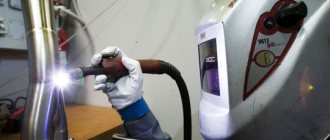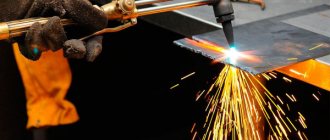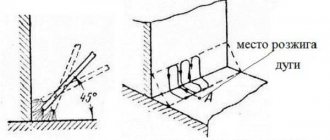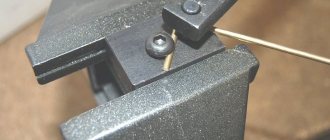Rolling, or rolling, as this technological operation is also called, involves plastic deformation of metal blanks to form them into products of the required configuration. In this case, both pipe rolling (to change the shape of their cross-section) and sheet metal processing can be performed, during which products of cylindrical, conical and oval configurations are created.
Profile forming on a three-roll machine
Rolling is performed on special equipment equipped with rollers, which are responsible for the plastic deformation of metal workpieces in the desired direction, which is why this technological operation received its name.
When rolling between rollers, the dimensions and distance between which are selected depending on the geometric parameters of the workpiece and the finished product, the workpiece acquires the required dimensions and shape. In some cases, metal rolling may involve not only rolling blanks from it, but also forging them.
You can roll not only workpieces made of metal, but also products made of polymer materials and rubber compounds, which are also characterized by high plasticity. If we talk about metal, then workpieces made of:
- certain grades of stainless steel;
- copper, aluminum and alloys of these metals;
- carbon steel alloys;
- galvanized steel.
In addition to rolling, there are technological operations such as flaring and rolling of edges, as a result of which the ends of tubes made of various metals are subjected to plastic deformation (and, accordingly, a change in geometric shape). For this purpose, a tool is used, the design of which may not have rollers. Using flaring and rolling, the ends of the tubes are prepared for their further connection. Miniature working rollers can be seen in a tool that is used to roll a pipe, that is, reduce its original diameter.
You can also roll the pipe using a lathe. A video with an example of performing such an operation can be seen below.
Corner bending (rolling)
It is thanks to the interaction with the rollers that radius bending of the corner is also called rolling.
Despite the apparent simplicity of the equipment, this is a very complex operation. When any solid material, including metal, is deformed, its inner layer experiences strong compression, and its outer layer experiences no less “extreme” tension. And if for such a product as a metal circle, these processes occur more or less evenly, in a corner, as in a profile workpiece, a longitudinal displacement of one of the layers can be observed. The risk of distortion of parts especially increases when using manual profile benders. Therefore, experts recommend bending a corner along a radius only on automated equipment, and better equipped CNC.
Basic Tools
Although this is not entirely true, the concept of metal rolling often refers to a whole list of technological operations by which the shape of a metal workpiece is changed. Such operations, in particular, include:
- formation of a round, square or rectangular profile from a narrow metal strip (using this method, welded pipes are produced; a similar technology is used to roll a metal angle);
- changing the cross-sectional shape, outer diameter and wall thickness of the finished tubular product - pipe rolling (using this technology, both seamless and welded tubular products can be processed);
- formation of bends with the required parameters in certain sections of the tubular product - pipe bending;
- production of sheet metal products of cylindrical (rolling of shells), conical (rolling of cones) and oval shapes;
- increasing the diameter (expansion) of the cut end of a metal pipe - flaring (using this technology, metal products are prepared for their connection with each other; in particular, this is how pipes for air conditioners are prepared for installation);
- reducing the diameter (narrowing) of the cut end of a tubular product - pipe rolling.
Rolling a profile pipe on a pipe bending machine
For rolling soft copper tubes, ordinary pliers can be used, and for flaring them, a tool whose working body is a conical element that expands the end of the pipe to the required amount. In fact, only those technological operations that are performed using equipment and tools that have rollers in their design can be called rolling.
Depending on the type of workpiece and the result that needs to be achieved, various equipment and tools can be used to perform rolling, which are most often quite versatile.
The industrial rolling machine is capable of bending large-sized sheet materials with high precision.
The process of rolling metal sheets, as a result of which they are formed into cylindrical, conical or oval-shaped products, is carried out on special equipment equipped with two, three or even four work rolls. Processing on a three-roll type machine consists in the fact that the metal sheet, pressing against two rotating lower rolls, the third - thrust, also begins to rotate around it, gradually turning into a cylindrical product. The bending radius of a metal sheet during rolling can be adjusted by selecting rolls of the appropriate diameter, as well as the distance between the lower working elements. Since rolls experience significant mechanical loads during operation, high-strength grades of steel alloys are used for their manufacture.
For pipe bending, which is often called rolling, equipment is used that is also equipped with a roll system. Bending around the work rolls during rotation, the product acquires the required angle or bending radius. This type of equipment, which is highly versatile, can also be used to roll angles.
The three-roll machine is designed for rolling profile pipes along an arc of any radius
Advantages of corner bending
Despite the existing risks, bending metal corners is used more often than other methods of changing the shape of a workpiece.
And there are several reasons for this: 1. This method is the most economical. It involves only a profile bender. Other possible works - cutting, welding operations, etc. - are not needed in this case; 2. The technology preserves the integrity of the metal, which means it remains invulnerable and its mechanical strength does not decrease; 3. That is why the use of bent structures, in contrast to welded ones and assembled using fasteners, greatly increases the service life of the product; 4. Unlike welding, after which the metal in the areas of impact is subject to corrosion, this does not happen with structures after radius bending of the corner.
Flaring of pipes during installation of heat exchange equipment
Installation of pipes in heat exchange systems, performed using a rolling operation, is a fairly common procedure, so it is better to become familiar with it in more detail. The use of such technology and high-quality tools makes it possible to obtain reliable connections between pipes and the walls of the holes made in the pipe drum.
Scheme of pipe rolling with a roller tool: 1 – spindle with a working cone; 2 – cage with bearing; 3 – rollers; 4 – pipe; 5 – tube grid
So, you need to do the following.
- A piece of pipe is installed in a hole whose diameter is smaller than its outer diameter.
- The working body of the tool is inserted into the inner part of the pipe and its expansion begins. Its diameter begins to increase under the influence of plastic deformation, and the gap between its outer wall and the wall of the hole into which it is inserted disappears. After removing the gap, the walls of the hole in the pipe drum begin to deform, on which pressure is exerted by the expanding pipe. Thus, a tight and reliable connection is formed.
- When rolling with such a tool, you should be very careful and make sure that the walls of the pipe do not collapse under the influence of significant pressure. This can happen if its diameter increases beyond the technology limit. Such negative consequences can be avoided not only by strictly following technological recommendations, but also by choosing the right tool.
So, rolling means a fairly large list of technological operations, for the quality implementation of which it is necessary to correctly select the appropriate tools and equipment.
Methods for bending a corner along a radius
Depending on the size of the workpiece and the thickness of the metal, bending can be done cold or hot.
Cold is preferable, since any heating is an effect at the level of the metal crystal lattice. Cold bending can be carried out not only on a rolling machine: for simple workpieces, the method of free bending of a corner along a radius is no less in demand - deformation of the corner “in weight”, without the use of special equipment. However, this technology may have errors, and it is better to use it for work that does not require high precision.
Based on the direction in which the workpiece is bent, a distinction is made between bending the corner with flanges outward or inward.
How to bend a corner into a ring with your own hands
To do this, it is best to use the hot method of metal processing. But you can achieve a given radius only with the help of a pre-prepared template. We preheat the metal and begin to bend the template evenly, while the horizontal shelf must be adjusted during the entire bending process using a sledgehammer or hammer, otherwise the shelves will not maintain the original angle of 90 degrees to each other.
It is necessary to heat the metal to half the value of its melting point, so, for example, an aluminum corner will have to be heated to at least 250⁰ C, and a steel profile - to 600⁰ C. To do this, you will need a natural gas burner or a gasoline blowtorch, and it is best to use welding acetylene cutter if the corner is large.
Using an angle grinder and a welding machine, you can also bend a steel corner into a ring, but for this you need to make fairly accurate calculations, mark and outline the sectors to be removed, bend and weld the seams. Unfortunately, no matter how hard you try, in this case you will end up with a circle in the form of a rounded polyhedron.
VIEW Bending machines on AliExpress →
Bending corners from different materials
Modern equipment for bending metal corners - machines equipped with CNC - can process products from any materials.
First of all, it is black and stainless steel. The operation is carried out so carefully that even rolled products coated with galvanization or a polymer protective layer can be passed through the rolls. Less common, but also in demand, is the bending of aluminum alloys. Very rarely, but such work is still performed for products made of copper, bronze and brass. These works are almost always decorative in nature.
Features of channel bending
In order for radial bending of a channel to be easy for the performer and harmless for the profile, the process cannot be approached “on the fly, with a turn.” Preparation is no less important than the technical implementation itself. To avoid problems, you must:
- study the properties of the workpiece in detail;
- determine the force that will be needed to bend it;
- calculate deformation values;
- configure the equipment.
And, as we have already mentioned, “practice” on a signal sample, take into account negative experience, if any, and only then proceed to serial production.
Cost of bending a metal corner
Prices for bending corners along a radius are considered one of the most affordable. They are influenced by:
- features of the metal from which the blanks are produced;
- number of blanks;
- corner size;
- shelf thickness;
- bending radius;
- urgency of work.
Where can I order aluminum corner bending?
On our website you can order professional, inexpensive and very fast bending of metal corners and other long products.
We work with workpieces of any range and made from any raw material - from steel to copper. The CNC equipment that our workshop is equipped with will help transform even non-standard parts in order to fulfill your individual order. Leave us a request online or dial a contact phone number - and you will see how high-quality and fast metalworking can be.
Steel channel bending
The technology and quality of steel channel bending largely depend on the type of material.
Carbon steels that are simpler in composition are more susceptible to deformation. The effectiveness of the same operation on alloyed ones depends on the inclusions of other elements: some of them reduce the ductility of the material and can negatively affect the process. The method of manufacturing the channel also makes its contribution: it is known that a profile produced by the cold method tolerates deformation better than a heat-treated - hot-rolled one. Some types of steel (for example, especially strong structural steel) can only be bent after preheating.









